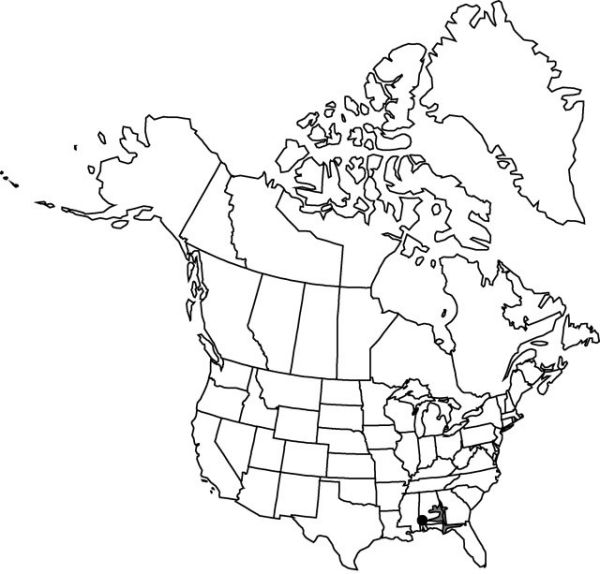Trillium underwoodii
Bull. Torrey Bot. Club 24: 172. 1897.
Rhizomes horizontal, brownish, short, thick, praemorse, not brittle. Scapes 1–2, round in cross-section, 0.8-2 dm, slender to stout, glabrous. Bracts usually drooping, often touching ground in early anthesis, sessile; blade pale silvery green, strongly mottled in 3 or more shades of dark green and bronze, sometimes maroon, mottling becoming obscure with age, ovatelanceolate to obovate, 6.5–12 × 5–7.8 cm, margins of distal 1/3 straight from rounded base to apex, apex acuminate. Flower erect, odor fetid, especially when first open; sepals displayed above bracts, spreading, green or purple on adaxial surface, lanceolate, 4.5–5 × 8–12 mm, margins entire, flat, apex rounded-acute; petals long-lasting, erect-spreading, ± connivent, ± concealing stamens and ovary or at least partially obscuring stamens, tips ± incurved, dark maroon-red, or purplish red, brownish maroon, or yellowish green, not spirally twisted, oblanceolate to elliptic, 3–5.5+ × 1–1.5 cm, usually 3–4 times longer than wide, thick-textured, margins entire, apex acute; stamens ± erect to weakly incurved, 14–17 mm; filaments purple, 1–2 mm; anthers 8–15 mm, thick, dehiscence latrorse; connectives brown-purple, straight, extended 1–2 mm beyond anther sacs, apex somewhat acute; ovary purple, ellipsoid, 6-angled, 6.3–11 mm; stigmas erect, abruptly recurved upon ovary, distinct, purplish, linear, 1.5–5 mm, slightly thickened basally, fleshy. Fruits baccate, purple-black to dull greenish maroon, odorless, ovoid to obovoid, 6-angled (ridged), 0.7–1 cm diam., pulpy, not juicy.
Phenology: Flowering mid winter–spring (late Feb–mid Apr).
Habitat: Rich to dryish deciduous forests of mature or second-growth timber, dominated by oaks or with beech-oaks, occasionally with scattered pines present, flat ground along streams where soil can be fairly moist, rich clay or sand
Elevation: 100–200 m
Distribution

Ala., Fla., Ga.
Discussion
Trillium underwoodii can cause considerable confusion for the beginning student of the genus. In some ways it closely resembles a small-statured T. cuneatum. As T. underwoodii continues to expand after flowering, it may become somewhat taller and less “ground hugging,” and it then appears similar to a smaller plant of T. decipiens, which grows in parts of the same range, especially when its bracts do not touch the ground at anthesis. It also has vague similarities to T. reliquum, with which it grows sympatrically in parts of its range. Care should be taken to observe the details of floral structure accurately.
Distribution of Trillium underwoodii is much more restricted than that given by J. K. Small (1933), who indicated a range extending from Alabama to North Carolina and Arkansas.
Selected References
None.
Lower Taxa
"thick" is not a number."compressed-shortened" is not a number. "elongated" is not a number."thick" is not a number."dm" is not declared as a valid unit of measurement for this property."thicker" is not a number.